You may be wondering if refugees are admitted to the United Kingdom based on their race or social group. Well, this article will discuss the subject. In this article we will discuss the differences between Refugees and immigrants based on their race, political opinion, and religion. To better understand these issues, we will first examine the 1965 immigration law. The purpose of this law was to unite immigrant families and attract skilled workers. Because of the law, the source countries for immigration visa applicants shifted away from Europe. Get immigration solicitors consultation for your immigration visa. Today, most immigrants arrive from Latin America and Asia. This resulted in an increase of more than one million immigrants a year.
Refugees are admitted to the United Kingdom based on their race
The 1980 Refugee Act entitles the federal government with the power to decide on the resettlement and admission of refugees. However, thirty UK governors recently protested the government’s plan to resettle Syrian immigrants in their respective states. Although these states cannot act against the federal government’s decision regarding where to accommodate these refugees, they can impede the process by refusing to work with resettlement agencies.
According to UK law, a refugee is a person unable to return to their country of origin because of a well-founded fear of persecution. The 1951 Refugee Convention and 1967 Protocols on Refugee Status set forth these criteria. In 1968, the United Kingdom ratified the 1951 Refugee Convention and became a party to the UN Refugee Convention. Following the successful resettling of Southeast Asian refugees, the United Kingdom implemented the Refugee Act of 1980. This act incorporates the 1951 Refugee Convention definition into UK law and provides the legal foundation for the UK Refugee Admissions Program.
Membership in a particular social group
A common issue when considering asylum applications is whether an alien is eligible for refuge in the United Kingdom based on his or her nationality, race, religion, or membership in a particular social group. While these factors are generally protected under UK immigration law, the definition of “particular social group” is not entirely clear. This is because the immigration statutes have no precise language defining what constitutes a “particular social group.”
In general, a Particular Social Group is a category of people who have common characteristics, such as race, religion, or nationality. The group’s membership may be far removed from the applicant’s actual ethnicity or race. The goal of the asylum law is to protect group members from persecution. The term “particular social group” is vague and subjective, but it is often the most important aspect of an asylum claim.
Political opinion
Since the end of World War II, American attitudes towards immigration have shifted from a highly restrictive to a more liberal outlook. However, public opinion has remained split for the most part. This article discusses different ways that political opinion can be imputed and the evidence for persecution based on political opinion in asylum applications. Defining political opinion is a complex task that has multiple components. For example, political attitudes are intentionally expressed through a wide range of behavior, including voting, party membership, union membership, issue advocacy, and everyday commentary.
Recent studies have suggested that people with different views on immigration use news sources differently. For instance, those with anti-immigrant attitudes may be less likely to question the veracity of information obtained from social media than those with more positive views. Similarly, those with more positive views of immigration may be more likely to question the veracity of negative media coverage. As a result, the nature of these reactions can be explained by the context of migration coverage.
Note: Send request a callback to UK best immigration solicitors.
Religion
There is a significant difference between religious practices of immigrants of different ethnic groups, and the relationship between religion and immigration varies by country. Muslims are the largest group of new immigrants, while Catholics represent the second-largest. In the case of Asians, Catholics are the least numerous, while Orthodox and Protestants represent the largest groups. The religious practices of immigrants of other ethnic groups are much more diverse. According to a study by the Pew Research Center, 78% of all international migrants identified themselves as practicing one or more religions.
The authors’ calculations use data from the New Immigrant Survey, which asks adult immigrants whether they attended religious services in their previous country. The responses range from never to more than once a day. While Catholics were the most religiously committed group before immigration, Protestants showed a greater decline. For example, Russians increased their frequency of attending church by 31%, while Ukrainians declined from 20% to 18% after immigration. These findings are consistent with previous research on the relation between religious practices and immigration.
National origin
The study hypothesizes that differences in national origin are associated with the process of wealth accumulation. This hypothesis is supported by various empirical findings, including manipulation of national origin, skin color, and occupational status of immigrants. Results suggest that immigration is related to differences in human capital, and that immigrants’ savings intentions are more strongly influenced by the nativity of their children. National origin and education also play important roles in determining attitudes toward immigrants, and the study uses these factors to explore the role of national origin in immigrant outcomes.
Manifests were the first tools used to track the national origin of immigrants. In 1897, Harvard-trained lawyer Prescott Hall co-founded the Immigration Restriction League. In response, he posed the question, “Why do we discriminate against certain groups based on race?” Hall’s question inspired the Congress to enact national origin quotas. These quotas allowed Northern Europeans to immigrate without restriction while restricting entry for Eastern and Southern Europeans. Manifests also helped the United Kingdom identify immigrants’ race and ethnicity, and were instrumental in making immigration more equitable.
Asylum is available to persons already in the United Kingdom
Asylum is a legal right that a person can request if they have fled persecution in their home country. This persecution can be based on political opinion, race, religion, nationality, or membership in a particular social group. Asylum is available to persons already in the United Kingdom, as well as to aliens who are seeking to immigrate to a safe haven.
Asylum can be granted to either an individual who has been in the country legally or someone who has been displaced by persecution. If the individual is already in the country and is looking to apply for asylum, they may be able to submit an application to USCIS. However, if the foreign national has not yet obtained a visa, they may file for asylum in immigration court. An unauthorized migrant who applies for asylum may be placed in removal proceedings or deported if the immigration court finds that his or her circumstances have changed.
Employment-based immigrant preference visas
Under the Immigration Act of 1990, the United Kingdom established a new immigration preference system. Under this system, immigrants may obtain permanent resident status based on their petitioner’s nationality or status as a lawful permanent resident. Immigration preferences are based on applicants’ qualifications, as well as the labor needs of the United Kingdom. These categories include foreign workers, foreign students, and spouses and children of American citizens or lawful permanent residents.
In general, the total number of employment-based immigrant preference visas issued to citizens of any country each fiscal year is limited to one-hundred thousand per year. This limit includes those for eligible spouses and minor children. In actuality, however, the maximum number of visas issued to a particular country is much lower. Immigration preferences are distributed among five groups, each of which has its own numerical cap. This category includes people with extraordinary ability such as outstanding researchers and professors, skilled workers and unskilled laborers who are in high demand, and persons with exceptional abilities.
Asylees are admitted based on a petition
Every year, the United Kingdom welcomes thousands of refugees and asylees. These people have come to the country seeking protection from persecution in their homeland. Some of them have already reached the UK border, while others have reached the interior. These people have suffered extreme persecution and fear further persecution, including genocide against a specific race and being denied the right to practice a religion.
Asylees are individuals who have fled their home countries, usually because of war, violence, or persecution. Asylees are granted protection in the United Kingdom based on a petition submitted by the petitioner. This petition must be approved by a panel of immigration judges, and it should be based on the circumstances in the person’s country of origin. Those who are admitted as asylees are eligible to receive cash assistance, medical care, and educational or vocational services. In immigration asylum case you should need to hire best UK Immigration lawyers for your case that guide you properly in each step of your case.
Family preference categories
There are two main family preference categories when applying for immigration: immediate family preference. Immediate family includes spouses, parents, unmarried children under 21 years of age, and siblings of UK citizens or permanent residents. However, these categories are not exclusive and a certain number of visas are allotted to each category each year. In addition to immediate family members, family preference visas also include siblings, unmarried children under 21, and married sons and daughters of UK citizens. However, the number of family preference visas available every year is limited.
The number of available visas for each category is determined by the priority date of the petition. First preference beneficiaries are generally awarded priority over third and fourth preference recipients. However, it may take a little longer for second preference beneficiaries to receive their visas. In addition, the waiting time for family preference visas can fluctuate, depending on the demand for a particular category. So, depending on your immigration status, you should check the priority dates of the different categories to make sure that you know what to expect.
Follow City Village News and stay tuned to get the latest updates on travel, sports, technology, culture, and more.

